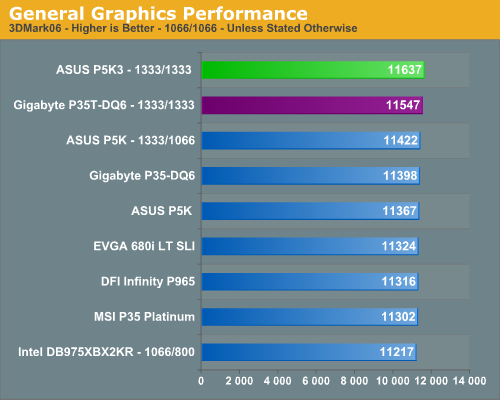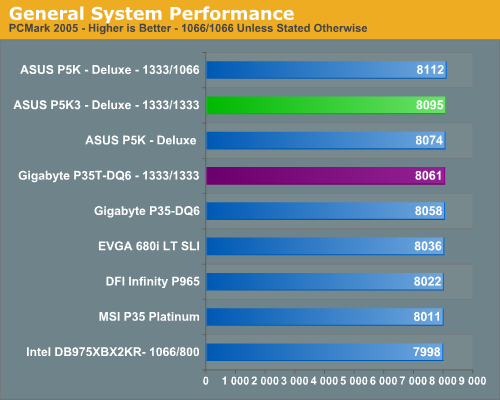Gigabyte GA-P35T-DQ6: DDR3 comes a knocking, again
by Gary Key on May 30, 2007 2:00 AM EST- Posted in
- Motherboards
Synthetic Graphics Performance
The 3DMark series of benchmarks developed and provided by Futuremark are among the most widely used tools for benchmark reporting and comparisons. Although the benchmarks are very useful for providing apples-to-apples comparisons across a broad array of GPU and CPU configurations they are not a substitute for actual application and gaming benchmarks. In this sense we consider the 3DMark benchmarks to be purely synthetic in nature but still very valuable for providing consistent measurements of performance.


In our 3DMark06 test, all of the boards are bunched together with a 3.7% spread from top to bottom. The 975X board takes last place by a small margin and we expect this to improve once we have new R600 drivers. The P5K3 board offered the best CPU and SM2.0 scores in this benchmark although the P35T-DQ6 offered the best SM3.0 scores. This is one of a few tests that show the ASUS DDR3 board to have slightly better performance than the Gigabyte DDR3 board when the benchmark is CPU limited.
In the more memory sensitive 3DMark01 benchmark we see our Gigabyte P35T-DQ6 board taking top honors with a very strong showing against the ASUS boards. Our 975X board is slightly handicapped at the 1066FSB/DDR2-800 settings although this chipset continues to offer excellent memory performance in this type of benchmark. The spread from top to bottom is only 2.6%, however, so minor differences in performance are not really noticeable in either 3DMark unless you count on the differences for individual benchmark scores.
General System Performance
The PCMark05 benchmark developed and provided by Futuremark was designed to evaluate overall system performance for the typical home computing user. This tool provides both system and component level benchmarking results utilizing subsets of real world applications or programs. This benchmark is useful for providing comparative results across a broad array of Graphics, CPU, Hard Disk, and Memory configurations along with multithreading results. In this sense we consider the PCMark benchmark to be both synthetic and real world in nature, and it again provides for consistency in our benchmark results.

The ASUS boards have always done well in this benchmark due to very strong multitasking performance and the same holds true once again in our test with the Gigabyte DDR3 board. The spread in overall scores is only 1.5%, although in individual areas the differences between the boards may be more or less pronounced.
The 3DMark series of benchmarks developed and provided by Futuremark are among the most widely used tools for benchmark reporting and comparisons. Although the benchmarks are very useful for providing apples-to-apples comparisons across a broad array of GPU and CPU configurations they are not a substitute for actual application and gaming benchmarks. In this sense we consider the 3DMark benchmarks to be purely synthetic in nature but still very valuable for providing consistent measurements of performance.


In our 3DMark06 test, all of the boards are bunched together with a 3.7% spread from top to bottom. The 975X board takes last place by a small margin and we expect this to improve once we have new R600 drivers. The P5K3 board offered the best CPU and SM2.0 scores in this benchmark although the P35T-DQ6 offered the best SM3.0 scores. This is one of a few tests that show the ASUS DDR3 board to have slightly better performance than the Gigabyte DDR3 board when the benchmark is CPU limited.
In the more memory sensitive 3DMark01 benchmark we see our Gigabyte P35T-DQ6 board taking top honors with a very strong showing against the ASUS boards. Our 975X board is slightly handicapped at the 1066FSB/DDR2-800 settings although this chipset continues to offer excellent memory performance in this type of benchmark. The spread from top to bottom is only 2.6%, however, so minor differences in performance are not really noticeable in either 3DMark unless you count on the differences for individual benchmark scores.
General System Performance
The PCMark05 benchmark developed and provided by Futuremark was designed to evaluate overall system performance for the typical home computing user. This tool provides both system and component level benchmarking results utilizing subsets of real world applications or programs. This benchmark is useful for providing comparative results across a broad array of Graphics, CPU, Hard Disk, and Memory configurations along with multithreading results. In this sense we consider the PCMark benchmark to be both synthetic and real world in nature, and it again provides for consistency in our benchmark results.

The ASUS boards have always done well in this benchmark due to very strong multitasking performance and the same holds true once again in our test with the Gigabyte DDR3 board. The spread in overall scores is only 1.5%, although in individual areas the differences between the boards may be more or less pronounced.










22 Comments
View All Comments
SirJoe - Saturday, June 2, 2007 - link
this is cool for you computer buffsGooger - Saturday, June 2, 2007 - link
I just did a google search for XMS3 and the only merchant to have it in stock at the bargain price of $599 is Tiger Direct! Yikes, I think I will wait a while untill the price of DDR3 becomes competitive with DDR2.AdamK47 - Wednesday, May 30, 2007 - link
Sorry Gigabyte, I just can't see myself ever buying a board with pink memory slots. Shoulda stuck with the blue.Stele - Friday, June 1, 2007 - link
"Pink it's my new obsessionPink it's not even a question..."
:D Sorry, couldn't resist the temptation :P
yacoub - Wednesday, May 30, 2007 - link
Thank you especially for the note about larger heatsinks being very difficult to mount and the associated image of the back of the motherboard so folks can see what they face if they have a heatsink that requires connecting a backing plate (as most of the larger ones do).yyrkoon - Wednesday, May 30, 2007 - link
What annoys me, is that every Gigabyte motherbord review has this same 'annoyance' written in. Come now fellas, you can only say it about 500 times, beore it starts getting old, and how hard is it really to press two keys in combination ? Gigabyte obviously is doing this for a reason, and if it takes me writting this comment to point that out, well, I just dont know . . .
Saying something like: 'You will need to press cntl + F1 to access the 'protected' portion of the BIOS . . .' Would sounds less critical, would not come off as negativity, and would keep you guys from sounding lazy . . .
TA152H - Wednesday, May 30, 2007 - link
It's not hitting the keys that is the problem, it's remembering to do it. When you have loads of computers with motherboards, it's nice if they have a standard way to access features, instead of adding an inane key sequence like CTRL-F1. It is annoying, because four years down the road if you have to work on this motherboard, for whatever reason, you have to try to remember this bizarre and otherwise trivial detail. Standards are nice, especially when following them doesn't involve a tradeoff.yyrkoon - Thursday, May 31, 2007 - link
Yeah, well I personally have a bad memory, but after reading countless Gigabyte motherboard reviews from AT here, I do not think I will ever forget this key combination.Anyhow, this is one reason why when given the chance I always opt for ABIT boards, while other may opt for Asus, Gigabyte, whatever. Once you become used to a given OEM BIOS Layout, it is hard to make a change in OEMs without suffering a bit in the knowledge department(at least temporarily).
*yyrkoon hugs his NF-M2 nView . . .
TA152H - Saturday, June 2, 2007 - link
Keep in mind, not everyone buying a motherboard from Gigabyte is going to be reading these articles, and proper journalism dictates they don't depend on people knowing every previous article, so they appropriately bring it up. Before you remark what's the point in them mentioning it for people that don't read it, it's certainly going to be read by Gigabyte and by complaining enough times, they may take notice.I agree that it is often best to just buy from one maker, or limit the number. Unfortunately, I'm an idiot and I end up with stuff from too many makers. I try to buy only Intel and Supermicro, but they are too expensive sometimes, so I've ended up buying a lot of Taiwanese junk before finally finding a company from there I have had success with (don't ask me why, but Epox seems to work best for me). So, I've got all this Asus, Soyo, Aopen, MSI, Gigabyte, Tyan and a few I don't even remember running and it's difficult to deal with all the different BIOS settings when they get cute and try to be different. On the plus side, these motherboards tend to break pretty regularly so I have less and less of the inferior brands. Well, except for Epox. I have no idea why these things never break on me, but I have a feeling it's just random luck :P .
Frumious1 - Wednesday, May 30, 2007 - link
I won't forget, but I'm still annoyed by this, just like I'm annoyed by a BIOS that moves certain features into odd areas. I hate that there are about 20 ways to manage memory timings, voltages, bus speeds, etc. (and that's just picking either an AMD or an Intel platform). What's really stupid about Gigabyte's method of hiding settings is that it's not even all of the settings that get hidden. The major area lately that doesn't show up is memory timings. You can tweak voltages and fry your RAM, but GOD FORBID you play with memory timings! (There are some other things that get hidden as well, but I don't recall exactly what. I base this off my DS3 system.)